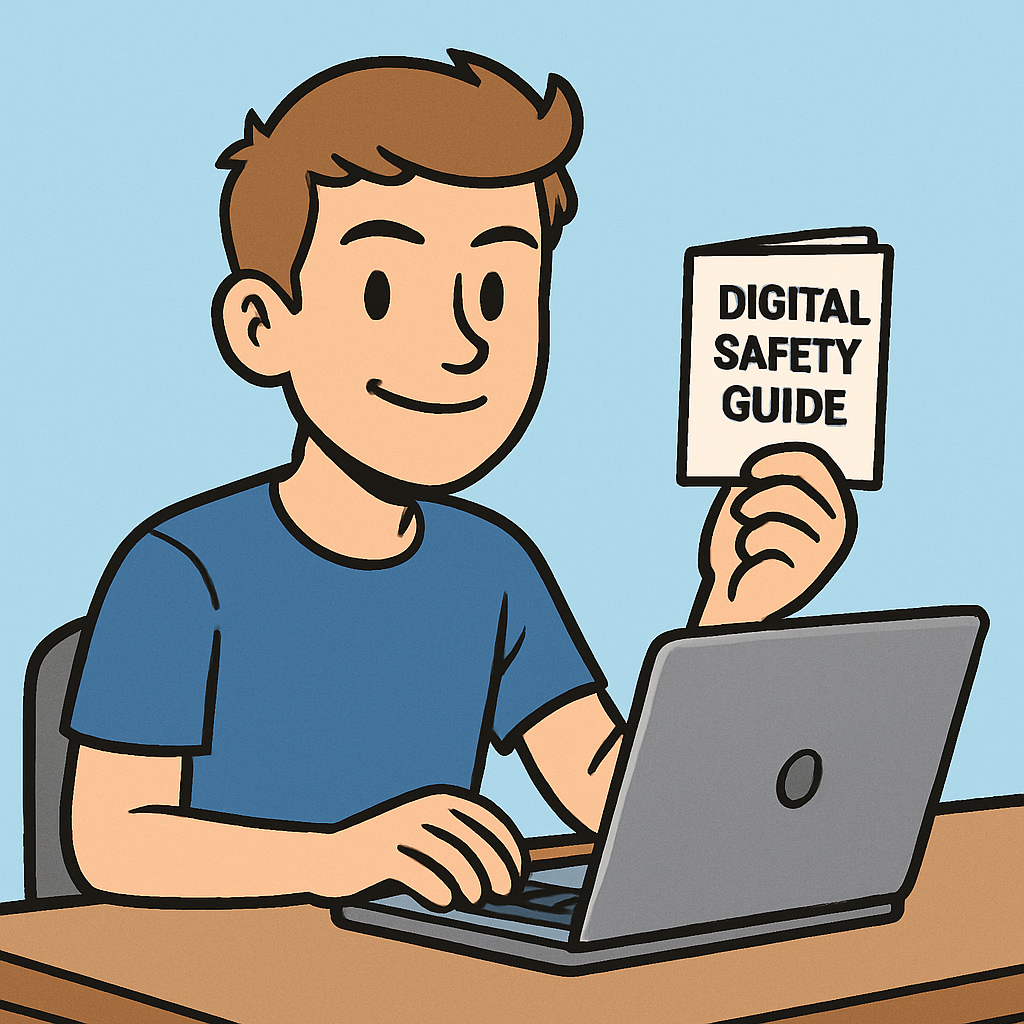 Over the past lessons, you've explored digital media, the internet, online safety, and web searching. Now, you'll put it all together by creating a Digital Safety Guide. This guide will help others stay safe online, covering topics like protecting personal information, creating strong passwords, understanding digital footprints, crafting effective searches, and identifying reliable sources.
Over the past lessons, you've explored digital media, the internet, online safety, and web searching. Now, you'll put it all together by creating a Digital Safety Guide. This guide will help others stay safe online, covering topics like protecting personal information, creating strong passwords, understanding digital footprints, crafting effective searches, and identifying reliable sources.
 Now that you're starting your capstone project, it's time to decide how you'll approach it—either on your own or with others. Working individually lets you go at your own pace and make all the decisions yourself, which can be great if you have a clear vision or prefer focusing without distractions. On the other hand, teaming up in a small group of 2-4 classmates allows you to bounce ideas off each other, share the workload, and learn from different perspectives, making the project more fun and creative.
Now that you're starting your capstone project, it's time to decide how you'll approach it—either on your own or with others. Working individually lets you go at your own pace and make all the decisions yourself, which can be great if you have a clear vision or prefer focusing without distractions. On the other hand, teaming up in a small group of 2-4 classmates allows you to bounce ideas off each other, share the workload, and learn from different perspectives, making the project more fun and creative.
If you choose to form a group, take a moment to discuss with your classmates who might want to join. Once your group is set, assign roles to ensure everyone contributes equally—for example, one person could be the researcher (gathering facts from previous lessons), another the designer (handling visuals and layout), a writer (crafting the text), and perhaps a reviewer (checking for accuracy and engagement). This way, the project runs smoothly and everyone feels involved.
 Now it's time to brainstorm ideas for your Digital Safety Guide. This is your chance to gather all the important concepts you've learned and organise them into a plan. Start by grabbing a notebook, a digital document, or even sticky notes to jot down your thoughts. Spend about 20 minutes on this step to ensure you have a solid outline before moving on to creating the guide.
Now it's time to brainstorm ideas for your Digital Safety Guide. This is your chance to gather all the important concepts you've learned and organise them into a plan. Start by grabbing a notebook, a digital document, or even sticky notes to jot down your thoughts. Spend about 20 minutes on this step to ensure you have a solid outline before moving on to creating the guide.
First, think back to the previous lessons. Recall key topics like: What is personal information and why is it crucial to protect it? How do you create strong passwords that are hard to guess? What's a digital footprint, how does it form, and what steps can you take to manage it effectively? How can you craft effective search queries to find what you need quickly, and what are the signs of reliable sources versus unreliable ones?
Next, list out the main sections you want to include in your guide. For each section, jot down key points, practical tips, real-life examples, and any warnings or common mistakes to avoid. Here are some ideas to spark your creativity:
To make your guide engaging, think about visual elements such as diagrams (e.g., a flowchart for creating passwords), checklists (e.g., a 'safety check' list), or infographics. Outline the overall structure—will it start with an introduction, have body sections, and end with a summary or quiz? If you're working in a group, discuss and combine everyone's ideas to create a unified plan.
By the end of this brainstorming session, you should have a clear outline that covers the essentials and feels exciting to build upon. This will make the creation step much smoother!
Time to build your guide! Start by reviewing the ideas and outline from your brainstorming session. This will help you organise your content effectively. Choose a digital tool that suits your format—such as a word processor like Google Docs or Microsoft Word for a document, presentation software like Google Slides or PowerPoint for slides, or a simple drawing tool like Canva for posters. If you're feeling adventurous and have access, you could even use a basic website builder like Google Sites.
Structure your guide with clear headings, bullet points, images, and straightforward explanations to make it easy to follow. Aim for at least four main sections, drawing directly from what you've learned in previous lessons. For example:
To make your guide more engaging, add elements like short quizzes (e.g., 'Is this a strong password?'), real-life scenarios (e.g., 'What would you do if someone asks for your address online?'), or simple diagrams (e.g., a flowchart for safe searching). Ensure all information is accurate and based on what you've learned—double-check against your notes from earlier lessons.
If working in a group, collaborate by assigning sections to different members and then combining them. Spend about 60 minutes creating, adding visuals, and refining your guide to make it polished and informative.
Now that your Digital Safety Guide is complete, it's time to share it with your classmates through a short presentation. This is your chance to showcase what you've created and reflect on the project.
Start by preparing: Outline the main points you want to cover, such as an overview of the guide's sections, why you selected those specific topics based on what you've learned in previous lessons, and how the guide can help others stay safe online. If you're working in a group, make sure every member has a part to speak about—perhaps one person introduces the guide, another explains key tips, and someone else shares examples or challenges faced.
Practice your presentation a couple of times to ensure it fits within 3-5 minutes. Speak clearly, make eye contact with your audience, and use your guide (like slides or the document) to illustrate your points. For example, you could demonstrate a section on strong passwords by showing a quick example from your guide. During the presentation, share any challenges you encountered, such as deciding on the structure or finding engaging visuals, and what you learned from overcoming them—like the importance of reliable sources or managing your digital footprint.
After presenting, be ready to answer a few questions from your classmates, and remember to listen attentively to others' presentations. Think about what you can learn from their ideas, such as new tips on online safety you hadn't considered.